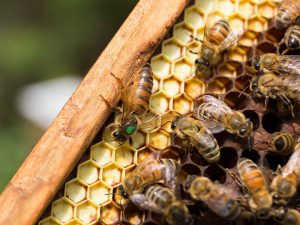
Beekeepers manage honey bees for many reasons: honey production, other honey bee products, pollination services, reduce Africanized genetic traits, or as an enjoyable hobby. Managing honey bees takes time, patience, knowledge, and skill. Watching and understanding colony congestion is one skill that requires experience. An amateur beekeeper may not recognize the signs of colony congestion before it is too late. Colony congestion is one reason why honey bees swarm. From early spring and throughout early summer, beekeepers must watch their colonies for fullness. When the colony’s population increases to a level (well before full capacity), the queen makes the decision to cut the colony in half and swarm. One half of the colony with the old queen will leave and create a temporary swarm while the other half will remain and attempt to re-queen their remaining colony.
Why split a hive?
The beekeeper’s goal is to split the hive through proper management practices before the queen makes this decision to swarm. When splitting the hive, the beekeeper will end up with two functioning colonies. Now, the bees have plenty of room to live and increase in size. When the beekeeper does not split the colony in time, thousands of honey bees may become a potential nuisance. (And a nuisance, I might add, not by the bee’s choice, but by our perceived thoughts).

Prior to swarming, the honey bees gorge themselves with stored honey to provide enough energy to reach their final destination. If you notice a swarm in a tree or on a structure in your yard, it is usually a temporary stay of 2-4 days. The honey bees are resting until the scout bees signal they found a new home. If they stay past a few days, call the Manatee County Extension Office, ask for Lisa Hickey, and discuss what you are seeing in detail. In some cases, the tree or structure in your yard could become their new home.
Need a pest control operator?
Swarm populations can be scary. Call a pest control operation if removal is necessary. However, please make sure they are trained in honey bee removal and eradication. This link provides a spreadsheet with trained professionals. Trained Honey Bee Removal Pest Control Operators
Lisa is a certified beekeeper, county extension agent, and currently enrolled in the University of Florida’s Master Beekeeper Program. Although she considers herself an amateur, her minor graduate credits are in entomology. She loved bee biology. Lisa has a wealth of resources available. She assist residents and communities in the understanding of honey bee basics and swarming activities. Call or email Lisa for more recourses. Lisa.Hickey@ufl.edu 941-722-4524 extension 1817. Our UF/IFAS webpage: Manatee County Agriculture Webpage
 0
0
